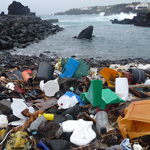
Principles of Sustainability
Chapter 3 - The Culture of Waste
Part 6 - Our Plastic Footprint
 Our culture of waste is most directly seen in our plastic footprint. The same qualities that make plastic a remarkable material, also contribute to its challenges as a waste material and a source of environmental pollution. The plastic we find in the oceans may be there, largely unchanged, for decades of centuries, with an impact to a marine ecosystem, we once thought too large to ever suffer irreversible damage from human activity.
Our culture of waste is most directly seen in our plastic footprint. The same qualities that make plastic a remarkable material, also contribute to its challenges as a waste material and a source of environmental pollution. The plastic we find in the oceans may be there, largely unchanged, for decades of centuries, with an impact to a marine ecosystem, we once thought too large to ever suffer irreversible damage from human activity.
As well, the chemical properties of many plastics contribute to risk concerns in highly contaminated environments and in human food chain exposures. A significant contingent of the research community, and a substantial body of published research suggests that human food and water contaminated by chemicals from plastics is a risk to health, with linkages to endocrine disruption and a myriad of diseases. That these chemicals from plastics are found in human tissues is now clear, even if the linkage to human disease is confounding and difficult to establish beyond correlation.
The future of any oil based product, like plastic, is certain to be difficult and expensive as a result of a future of declining oil reserves. Many consider the solution is to embrace a cultural shift away from our single serving, single use mentality. Establishing a composting program like Germany in the European Union so that Bioplastics can actually be composted, is a clear choice for communities and for packaging manufacturers.
That we transform the cycle of consumption is key, but there is a need for new materials sourced for biodegradation and ease of recycling, and as individual and communities, we need to recycle. Our own personal choices will help define the advance or retreat, from our society’s plastic footprint.
![]()
Keywords
- plastic
- bioplastic
- thermosetting plastics
- thermoplastics
- HDPE/LDPE
- polyurethane (PU), epoxide (EP), phenol-formaldehyde or phenolic ( PF), polytetrafluoroethylene (PTFE/Teflon), unsaturated polyester resins (UP), melamine formaldehyde (MF), silicone (SI), Polyimide (PI).
- polyethylene (PE), polystyrene (PS), expanded polystyrene (EPS), polyvinylchloride (PVC), polycarbonate (PC),polyethylene terephthalate (PET), polymethyl methacrylate (PMMA), polypropylene (PP), polytetrafluoroethylene (PTFE), acrylonitrile butadiene styrene (ABS)
- bisphenol A (BPA)
- marine debris
- plastic footprint
- durable goods
- non-durable goods
- containers and packaging
- plastic resin pellets (nurdles)
- Resin Identification Code
- polylactic acid (PLA)
- polyhydroxy-alkanoate (PHA)
Reading
- Moore, Charles J. (2008) “Synthetic polymers in the marine environment: A rapidly increasing, long-term threat.” Environmental Research. 108:2 pp. 131-139.
- 5Gyres Institute
- Algalita Marine Research Institute
(Photo: courtesy of Algalita Marine Research Foundation)
